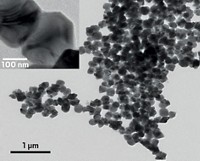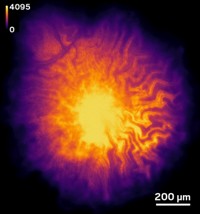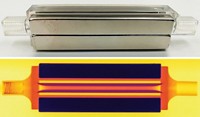Advertisement
Grab your lab coat. Let's get started
Welcome!
Welcome!
Create an account below to get 6 C&EN articles per month, receive newsletters and more - all free.
It seems this is your first time logging in online. Please enter the following information to continue.
As an ACS member you automatically get access to this site. All we need is few more details to create your reading experience.
Not you? Sign in with a different account.
Not you? Sign in with a different account.
ERROR 1
ERROR 1
ERROR 2
ERROR 2
ERROR 2
ERROR 2
ERROR 2
Password and Confirm password must match.
If you have an ACS member number, please enter it here so we can link this account to your membership. (optional)
ERROR 2
ACS values your privacy. By submitting your information, you are gaining access to C&EN and subscribing to our weekly newsletter. We use the information you provide to make your reading experience better, and we will never sell your data to third party members.
Pollution
Tiny robots with polymer ‘hands’ capture bacteria and microplastics in water
Microbots that self-assemble into planar swarms can catch free-swimming microbes
by Payal Dhar, special to C&EN
May 21, 2024

Free-swimming bacteria are some of the peskiest water pollutants around. They can travel and spread very quickly. They also form films, adhering to the inner walls of tanks and pipes; in this state, they become far more antibiotic resistant. Researchers at Martin Pumera’s Future Energy and Innovation Lab at the Central European Institute of Technology have come up with a novel way to deal with these microbes. They designed magnetically controlled swarms of microbots equipped with “hands” to capture free-swimming bacteria and microplastics (ACS Nano. 2024, 10.1021/acsnano.4c02115).
The microbots, each less than 3 µm in diameter, are fabricated from Dynabeads (spherical beads that exhibit magnetic properties only when placed in a magnetic field) coated with strands of a polymer with antibacterial properties. The positively charged polymer forms the hands of the microbots and is designed to electrostatically trap bacteria and microplastics, whose surfaces are negatively charged. The polymer also interferes with the bacteria’s cell-to-cell communication, an ability that allows them to carry out coordinated actions such as film formation.
When a magnetic field is applied, the bots self-assemble into swarms of flat rotating planes. Swarm size and propulsion speed can be modulated by adjusting the magnetic field. The planes sweep forward together through the water in a coordinated pattern, which lets them capture free-swimming bacteria and microplastics.
“The ‘hands’ can be tailored to selectively capture specific types of bacteria or pollutants, offering targeted contamination removal,” says Martina Ussia, first author of the study. A magnetic field applied in 10 s intervals over 30 min in samples ranging from 200 μl to 1 ml, at a robot concentration of 7.5 mg per ml, took out about 70% of the bacteria. The researchers estimated that the system removed more than half of the microplastics.
Once they sweep through a body of water, the microbots can be collected with permanent magnets and the remaining bacteria killed with UV radiation. Meanwhile, the microbots can be decontaminated using ultrasound and made ready for reuse. “We were able to remove up to 50% of bacteria and plastics for three subsequent cycles,” Ussia reports.
Satarupa Dey, a microbiologist at the Shyampur Siddheswari Mahavidyalaya, a college associated with the University of Calcutta, found this a novel way to approach water pollution. The polymer used prevents biofilm formation, which is a big plus, Dey says, as plastic waste can also contain bacterial biofilms. But she doesn’t consider the system cost-effective for addressing large-scale pollution, especially in resource-poor settings. “The Dynabeads and the polymer used—I don’t think that will be that cheap in large-scale [remediation].” In addition, she says, there are hundreds of types of pollutants in water, and this system seems to be targeting only two.
Ussia agrees that further research and development are needed to improve the microbots’ performance, scalability, and cost-effectiveness.





Join the conversation
Contact the reporter
Submit a Letter to the Editor for publication
Engage with us on Twitter